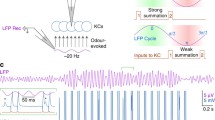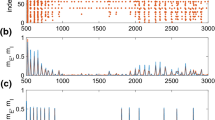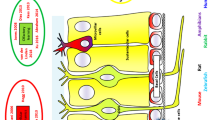Abstract
Across species, primary olfactory centers show similarities both in their cellular organization and their types of olfactory information coding. In this article, we consider an excitatory-inhibitory spiking neural network as a model of early olfactory systems (antennal lobe for insects, olfactory bulb for vertebrates). In line with experimental results, we show that, in our network, odor-like stimuli evoke synchronization of excitatory cells, phase-locked to the oscillations of the local field potential. As revealed by a mathematical analysis, the phase-locking probability of excitatory cells is given by an inverted-U function and the firing probability of inhibitory cells is well described by a sigmoid function. These neural response functions are used to reduce the spiking model to a more abstract model with discrete-time dynamics (oscillatory cycles) and binary-state neurons (phase-locked or not). An iterative map, built for explaining the dynamics of the binary model, reveals that it converges to fixed point attractors similar to those obtained with the spiking model. This result is consistent with odor-specific attractors found in recent experimental studies. It also provides insights for designing bio-inspired olfactory associative memories applicable for data analysis in electronic noses.
Similar content being viewed by others
Reference
Bazhenov M, Stopfer M, Rabinovich M, Huerta R, Abarbanel H, Sejnowski T, Laurent, G (2001). Model of transient synchronization in the locust antennal lobe. Neuron 30:553–567
Börgers C, Kopell N (2003) Synchronization in networks of excitatory and inhibitory neurons with sparse, random connectivity. Neur Comput 15:509–538
Buonviso N, Amat C, Litaudon P, Roux S, Royet J.-P, Farget V (2003) Rythm sequence through the olfactory bulb layers during the time window of a respiratory cycle. European J Neurosci 17:1811–1819
Chow C, White J, Ritt J, Kopell N (1998) Frequency control in synchronized networks of inhibitory neurons. J Comput Neurosci 5:407–420
Cortes C, Vapnik V (1995) Support vector networks. Machine Learning 20:1–25
Davison A, Feng J, Brown D (2003) Dendrodendritic inhibition and stimulated odor responses in a detailed olfactory bulb network model. J Neurophysiology 90:1921–1935
Eeckman F, Freeman W (1991) Asymmetric sigmoid non-linearity in the rat olfactory system. Brain Res 557:13–21
Ermentrout B (1996) Type 1 membranes, phase resetting curves, and synchrony. Neural Comput 8:979–1001
Friedrich R, Habermann C, Laurent G (2004) Multiplexing using synchrony in the zebrafish olfactory bulb. Nat Neurosci 7:862–871
Friedrich R, Laurent G (2001) Dynamic optimization of odor representations by slow temporal patterning of mitral cells activity. Sci 291:889–894
Gálan R, Sachse S, Galizia C, Herz A (2004) Odor-specific attractor dynamics in the antennal lobe allow for simple and rapid olfactory pattern classification. Neural Comput 16:999–1012
Gerstner W, Kistler W (2002) Spiking Neuron Models - Single Neurons, Populations, Plasticity Cambridge Univ. Press.
Graham B, Willshaw D (1995) Improving recall from an associative memory. Biol Cybernet 72:337–346
Hendin O, Horn D, Tsodyks M (1997) The role of inhibition in an associative memory model of the olfactory bulb. J Comput Neurosci 4:173–182
Hirase H, Recce M (1996) A search for the optimal thresholding sequence in an associative memory. Network: Computation in Neural Systems 7:741–756
Holub A, Laurent G, Perona P (2002) A digital antennal lobe for pattern equalization: analysis and design, Volume 15. Advances in Neural Information Processing Systems
Hoppenstead F, Izhikevich, E (2002) Canonical neural models in Brain theory and neural networks, 2nd Ed. MIT Press, Cambridge, MA.
Horn D, Usher M (1991) Parallel activation of memories in an oscillatory neural network. Neural Comput 3:31–43
Horn D, Usher M (2003) Neural networks with dynamical thresholds. Phys Rev A 40:1036–1044
Hosler J, Buxton K, Smith B (2000) Impairment of olfactory discrimination by blockade of gaba and nitric oxide activity in the honey bee antennal lobes. Behavioral Neurosci 114:514–525
Kashiwadani H, Sasaki Y, Uchida N, Mori K (1999) Synchronized oscillatory discharges of mitral/tufted cells with different molecular receptive ranges in the rabbit olfactory bulb. J Neurophysiology 82:1786–1792
Lagier S, Carleton A, Lledo P-M (2004) Interplay between local gabaergic interneurons and relay neurons generate γ oscillations in the rat olfactory bulb. The J Neurosci 24:4382–4392
Laurent G (1996) Dynamical neural assemblies. TINS 19:489–496
Laurent G (1999) A systems perspective on early olfactory coding. Sci 286:723–728
Laurent G, Davidowitz H (1994) Encoding of olfactory information with oscillating neural assemblies. Sci 265:1872–1875
Laurent G, Stopfer M, Friedrich R, Rabinovich M, Volkovskii A, Abarbanel H (2001). Odor coding as an active, dynamical process: experiments, computation and theory. Annu. Rev. Neurosci 24:263–297
Laurent G, Wehr M, Davidowitz D (1996) Temporal representations of odors in an olfactory network. The J Neurosci 16:3837–3847
Li Z, Hertz J (2000) Odor recognition and segmentation by a model olfactory bulb and cortex. Network: Comput in Neural Systems 11:83–102
Li Z, Hopfield J (1989). A model of the olfactory bulb and its oscillatory processing. Biol Cybernet 61:379–392
Linster C, Masson C (1996) A neural model of olfactory sensory memory in the honeybee’s antennal lobe. Neural Computation 8:94–114
Margrie T, Schaefer A (2003) Theta oscillation coupled spike latencies yield computational vigour in a mammalian sensory system. J Physiol 46:363–374
Martinez D (2005) Oscillatory synchronization requires precise and balanced feedback inhibition in a model of the insect antennal lobe. Neural Comput, In press
Ng M, Roorda R, Lima S, Zemelman B, Morcillo P, Miesenbock G (2002) Transmission of olfactory information between three populations of neurons in the antennal lobe of the fly. Neuron 36:463–474
Nusser Z, Kay L, Laurent G, Homanics G, Mody I (2001) Disruption of gaba a receptors on gabaergic interneurons leads to increased oscillatory power in the olfactory bulb network. J Neurophysiol 86:2823–2833
Palm G (1980) On associative memory. Biol Cybernet 36:19–31
Perez-Orive J, Mazor, Turner G, Cassenaer S, Wilson R, Laurent G (2002) Oscillations and sparsening of odor representations in the mushroom bodies. Sci 297:359–365
Quenet B, Horn D (2003). The dynamic neural filter: a binary model of spatiotemporal coding. Neural Comput 15:309–329
Raman B, Gutierrez-Osuna R (2004) Chemosensory processing in a spiking model of the olfactory bulb: chemotopic convergence and center surround inhibition. Advances in Neural Information Processing Systems 17 (NIPS 2004), Vancouver, BC, December, 2004 pp 13–16
Ravel N, Chabaud P, Martin C, Gaveau V, Hugues E, Tallon-Baudry C, Bertrand O, Gervais R (2003) Olfactory learning modifies the expression of odour-induced oscillatory responses in the gamma (60-90 hz) and beta (15-40 hz) bands in the rat olfactory bulb. European J Neurosci 17:350–358
Rubin J, Bose A (2004) Localized activity patterns in excitatory neuronal networks. Networks: Comput Neural Syst 15:133–158
Sachse S, Galizia C (2003) The coding of odour-intensity in the honeybee antennal lobe: local computation optimizes odour representation. European J Neurosci 18:2119–2132
Schein A, Saul L, Ungar L (2003) A generalized linear model for principal component analysis of binary data. Proceedings of the Ninth International Workshop on Artificial Intelligence and Statistics (matlab code available at http://www.cis.upenn.edu/∼ais) pp 14–21
Schwencker F, Sommer F, Palm G (1996) Iterative retrieval of sparsely coded associative memory patterns. Neural Networks 9:445–455
Stopfer M, Bhagavan S, Smith, B, Laurent G (1997) Impaired odor discrimination on desynchronisation of odor-encoding neural assemblies. Nat 390:70–74
Stopfer M, Jayaraman V, Laurent G (2003) Intensity versus identity coding in the olfactory system. Neuron 39:991–1004
Stopfer M, Laurent G (1999) Short-term memory in olfactory network dynamics. Nat 402:664–668
Strausfeld N, Hildebrand J (1999)s Olfactory systems: common design, uncommon origins? Curr Opinion in Neurobiol 9:634–639
Wehr M, Laurent G (1996) Odour encoding by temporal sequences of firing in oscillating neural assemblies. Nat 384:162–166
Willshaw D, Buneman O, Longuet-Higgins H (1969) Non-holographic associative memory. Nat 222:960–962
Author information
Authors and Affiliations
Corresponding author
Rights and permissions
About this article
Cite this article
Martinez, D. Detailed and abstract phase-locked attractor network models of early olfactory systems. Biol Cybern 93, 355–365 (2005). https://doi.org/10.1007/s00422-005-0010-3
Received:
Accepted:
Published:
Issue Date:
DOI: https://doi.org/10.1007/s00422-005-0010-3




